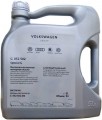The degree of oil viscosity, determined according to the international SAE standard. Viscosity is one of the key physical characteristics of an oil that determines its compatibility with a particular engine. Most modern brands of oil are all-weather and are designed for use, incl. and at low temperatures. Therefore, the SAE index for them includes information not only on the viscosity characteristics in a warm engine, but also on frost resistance.
Such an index is usually written in the form of two digits separated by the letter w:
0w-8,
0w-12,
0w-15,
0w-16,
0w-20,
0w-30,
0w-40,
0w-50,
5w-20,
5w -30,
5w-40,
5w-50,
5w-60,
10w-30,
10w-40,
10w-50,
10w-60,
15w-40,
15w-50,
15w-60,
20w-20,
20w-50,
20w-60,
...25w-40. There is also the format SAE 10w, SAE 20, SAE 30, SAE 40 and SAE 50. The first number describes only the cold resistance of the oil, and does not apply to its properties when the engine is warm. If 35 is subtracted from this number, you get the minimum temperature at which the engine can be cranked over to start. In our example, this temperature will be 15-35=-20 °C. Of course, such values are rather arbitrary, because In practice, other factors must also be taken into account. For example, with a “dead” battery (which is not uncommon in cold weather), a cold start can cause difficulties even at a higher temperature than follows from the characteristics of the oil.
The second number determines the characteristics of the oil in a warm engine in normal mode, at normal operating temperatures. It is this indicator that is the main one for choosing a brand of lubricant for a particular car - you must strictly adhere to the manufacturer's recommendations. The fact is that each engine is designed based on strictly defined viscosity values. An oil that is too viscous will linger in large quantities in moving parts, and one that is too fluid will leave them without lubrication at all; In both cases, power drops and wear increases. Therefore, first of all, when choosing according to SAE, the second number and its correspondence to the characteristics of the engine should be taken into account.International standards, compliance with which is stated in the characteristics of this brand of oil. In modern brands of oil, the following options may be found:
— API — a standard developed in the USA by the American Petroleum Institute. It provides for two separate classifications — for gasoline (
API SG,
SH,
SJ,
SL,
SM,
SN,
SN RC,
SN Plus,
SN Plus RC,
SP,
SP RC,
SP Plus) and for diesel engines (
API CI-4,
CH-4,
CG-4,
CF,
CE,
CD); in the first case, the letter S comes first in the standard designation (for example, API SL), in the second case, C (for example, API CI-4). If the oil is suitable for both types of engines, a double designation is used — for example, API SL/CI-4; in this case, the index of the type for which the oil is best suited comes first (in our example, it is gasoline). The standard also includes a classification of two-stroke engines — TA, TB
..., TC, TC+, TD.
— ACEA — a standard used by the eponymous association of European automakers, an alternative to the American API. Includes three classes: A/B — all oils developed before 2004 for different types of engines. Actually, before 2004 there were two classes — A for gasoline engines and B for diesel engines; then they were combined ( A1/B1, A3/B3, A3/B4 and A5/B5). However, separate designations can still be used. C — oils for all types of engines that meet the Euro-4 environmental standard and are compatible with additional equipment such as catalytic converters and particulate filters. There are APEA C1, C2, C3, C4 and C5. E — a separate class for diesel engines of heavy equipment, including special ones. It has the marking APEA E4, E6, E7 and E9.
— JASO — developed by the Japanese Association of Automobile Standards. It is one of the main modern standards for oils for gasoline motorcycle engines, within this purpose it has two classes — F for two-stroke engines, namely FA, FB, FC, FD and M for four-stroke (subclass MA for wet clutch MA-1 and MA-2, MB for dry). And also a new GLV-1 approval for ultra-efficient gasoline engines and hybrid power plants.
— ILSAC is a standard created jointly by the American and Japanese Automobile Manufacturers Associations. It is used for oils designed for passenger cars with gasoline engines. There are only five ILSAC categories ( GF-2, GF-3, GF-4, GF-5, GF-6A), in general they are similar to certain API categories (see above), but differ in increased requirements for energy saving and limiting harmful emissions.
The list of specific oil standards recommended by the manufacturer for a particular engine is usually specified in the official specifications of the vehicle. Note that many standards are interchangeable; compatibility data (as well as a description of each individual category) can be found in specialized sources.An engine oil quality standard that VAG considers essential for correct operation when used in the engine of its vehicles. For various engines (respectively, car brands) there is a standard, among which there are
500.00,
501.01,
502.00,
503.00,
503.01,
504.00,
505.00,
505.01,
506.00,
506.01,
507.00,
508.00, and
508.00 ,
